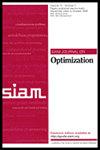Decentralized Gradient Descent Maximization Method for Composite Nonconvex Strongly-Concave Minimax Problems
IF 2.3
1区 数学
Q1 MATHEMATICS, APPLIED
引用次数: 0
Abstract
SIAM Journal on Optimization, Volume 34, Issue 1, Page 1006-1044, March 2024.Abstract. Minimax problems have recently attracted a lot of research interests. A few efforts have been made to solve decentralized nonconvex strongly-concave (NCSC) minimax-structured optimization; however, all of them focus on smooth problems with at most a constraint on the maximization variable. In this paper, we make the first attempt on solving composite NCSC minimax problems that can have convex nonsmooth terms on both minimization and maximization variables. Our algorithm is designed based on a novel reformulation of the decentralized minimax problem that introduces a multiplier to absorb the dual consensus constraint. The removal of dual consensus constraint enables the most aggressive (i.e., local maximization instead of a gradient ascent step) dual update that leads to the benefit of taking a larger primal stepsize and better complexity results. In addition, the decoupling of the nonsmoothness and consensus on the dual variable eases the analysis of a decentralized algorithm; thus our reformulation creates a new way for interested researchers to design new (and possibly more efficient) decentralized methods on solving NCSC minimax problems. We show a global convergence result of the proposed algorithm and an iteration complexity result to produce a (near) stationary point of the reformulation. Moreover, a relation is established between the (near) stationarities of the reformulation and the original formulation. With this relation, we show that when the dual regularizer is smooth, our algorithm can have lower complexity results (with reduced dependence on a condition number) than existing ones to produce a near-stationary point of the original formulation. Numerical experiments are conducted on a distributionally robust logistic regression to demonstrate the performance of the proposed algorithm.
复合非凸强凹最小问题的分散梯度下降最大化方法
SIAM 优化期刊》,第 34 卷第 1 期,第 1006-1044 页,2024 年 3 月。 摘要最小问题最近引起了很多研究兴趣。然而,所有这些研究都集中在平滑问题上,而且最大化变量上最多只有一个约束。在本文中,我们首次尝试求解复合 NCSC minimax 问题,这些问题可能在最小化变量和最大化变量上都存在凸非光滑项。我们的算法是基于对分散最小问题的一种新的重新表述而设计的,它引入了一个乘数来吸收双重共识约束。去除对偶共识约束后,就能进行最激进的对偶更新(即局部最大化,而不是梯度上升步骤),从而获得更大的原始步长和更好的复杂度结果。此外,对偶变量的非光滑性和共识的解耦简化了分散算法的分析;因此,我们的重新表述为感兴趣的研究人员设计新的(可能更有效的)分散方法来解决 NCSC minimax 问题提供了新的途径。我们展示了所提算法的全局收敛结果和迭代复杂度结果,从而得出了重构算法的(近)静止点。此外,我们还建立了重新计算的(近)静止点与原始计算之间的关系。利用这种关系,我们证明了当对偶正则器是平滑的时,我们的算法可以比现有算法得到更低的复杂度结果(对条件数的依赖性降低),从而产生原始公式的近静止点。我们对分布稳健的逻辑回归进行了数值实验,以证明所提算法的性能。
本文章由计算机程序翻译,如有差异,请以英文原文为准。
求助全文
约1分钟内获得全文
求助全文
来源期刊

SIAM Journal on Optimization
数学-应用数学
CiteScore
5.30
自引率
9.70%
发文量
101
审稿时长
6-12 weeks
期刊介绍:
The SIAM Journal on Optimization contains research articles on the theory and practice of optimization. The areas addressed include linear and quadratic programming, convex programming, nonlinear programming, complementarity problems, stochastic optimization, combinatorial optimization, integer programming, and convex, nonsmooth and variational analysis. Contributions may emphasize optimization theory, algorithms, software, computational practice, applications, or the links between these subjects.
 求助内容:
求助内容: 应助结果提醒方式:
应助结果提醒方式:


